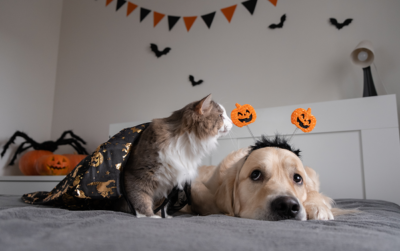
Spooky Season is upon us—children and adults alike want to celebrate like it’s 2019 and bust out the costumes, candy, and decorations! With many of the COVID restrictions lifted or lightened, this year might be a busy night of spooky fun for families waiting for the return of a regular Hallowe’en night. That said, animals can’t comprehend why Dad suddenly resembles Homer Simpson, the doorbell keeps misfiring, or the Disney zombie apocalypse is starting outside their window. Some pets are into all the action, and some find it frightening. Either way, it’s important to keep them in mind so they can be safe, secure, and stress-free.
Keep decorations animal friendly.
- Supervise candles and Jack-o-lanterns when they’re lit and keep them out of reach.
- Put fake spiderwebs out of reach, so no hair, whiskers, or wings get caught in them.
- Keep late-night flashing lights out of your pets’ sight, as they can be disturbing, particularly for crepuscular and nocturnal animals.
- Avoid small parts that could be choking hazards and beware of electrical cords that your bunny or bird could be tempted to chew on.
- Consider providing Hallowe’en-themed hideouts for your pets, too (they look the part and give your pet a safe refuge if they get overwhelmed by all the changes).
- Be careful with glow sticks and glowing accessories—while the glowing substance within isn’t poisonous in small amounts, it can still cause a curious pet to drool, wretch, or vomit if chewed into.
- Make your own pet-friendly fake blood because most commercially available options contain propylene glycol, which is toxic to pets if ingested.
Keep your pets indoors.
- When it’s time to host party guests or trick-or-treaters, keep your pets secure indoors and away from visitors and revolving doors.
- If your dog insists on greeting people at the door, keep him close to you on a leash.
- Contain your cat to a room or area of the house so she doesn’t sneak out (she may prefer her own hideaway anyway).
- Birds and small mammals should be secured in their cages, ideally in another pet-proofed room or with appropriate cage covers.
Having your pets microchipped will help you find them if they somehow get outside. Even if your pet is accustomed to being outside, the unusual decorations, lights, and groups of people can be disorientating and raise the risk of getting lost.
Let your pets decide if they are dressing up, too. There may be costumes for every pet, but not every pet wants to wear them, especially if they are restricting, uncomfortable, or embarrassing.
- If your pet is cool with costumes, choose one that fits well and allows natural movement, such as jumping to the top of a cat tree, climbing perch-to-perch, or running away from something spooky.
- It’s also important to supervise your pet while wearing a costume or accessory and to keep dress-up time brief. If your pet tries to get the costume off, freezes, hides, or paces restlessly, it’s time to undress.
- Be mindful that some pets display stress differently, especially rabbits and birds, and it is essential to recognize and respond to their subtle cues.
Don’t share the candy! Dark chocolate is the biggest no-no, but here are a few others that you might not know about:
- Candies with high sugar content (e.g., candy corn, gummy/chewy candies, suckers, cotton candy, caramel, etc.)
- Candies sweetened with xylitol, which is harmful to all pet species (e.g., sugar-free candy and gum, and certain types of syrups, peanut butter, and baked goods)
- Raisins are particularly toxic to cats, dogs, and ferrets but are OK for birds and small mammals if they’re plain and given in small amounts.
- Milk chocolate—the amount of cocoa in it isn’t as dangerous as dark chocolate, but the added sugar and fat are harmful to any pet.
Mistakes happen, too, especially with lots of kids or houseguests around your pets; if you think your pet overindulged or got into some of the wrong candy, call your veterinarian or local emergency clinic immediately.
Keep it spooky and safe, everyone!